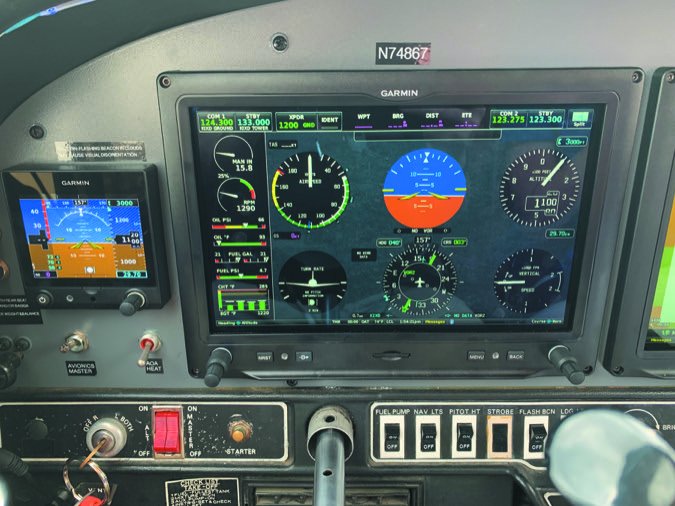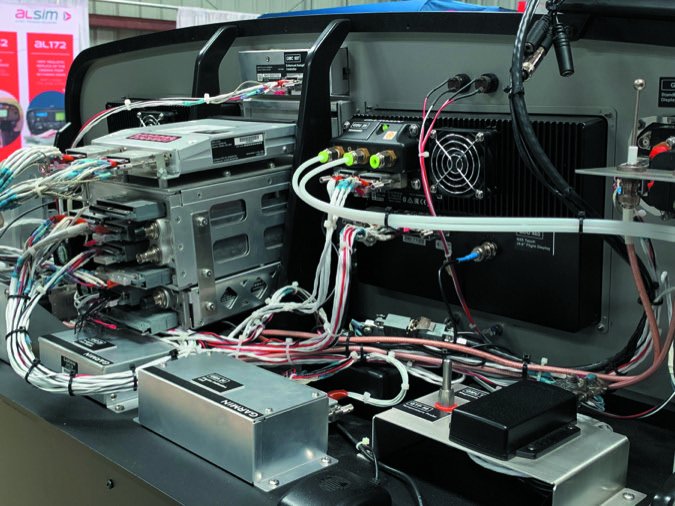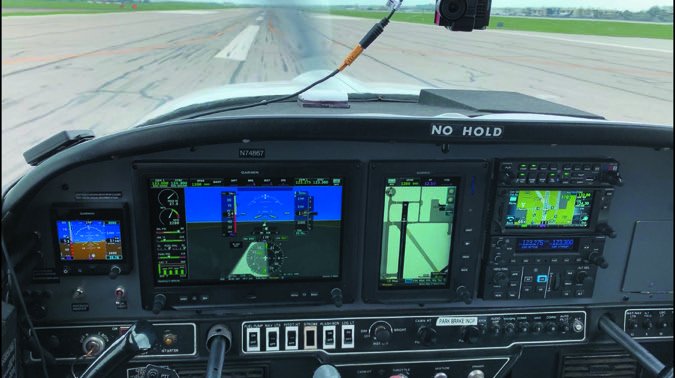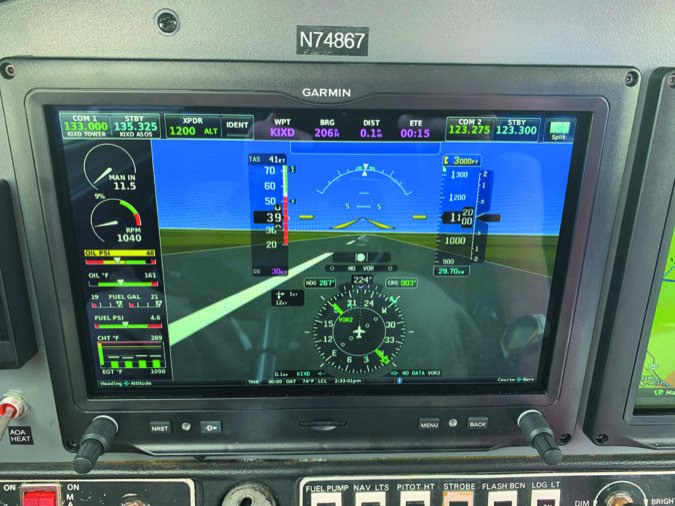During a recent visit to Garmin’s flight ops in Olathe, Kansas, I of course respected the request to shut down the cameras in some of the classified work hangars. But let’s be clear – Garmin is serious about earning new STCs for a variety of products in an extremely wide variety of aircraft – from pistons to turbines. And that STC list is quickly growing.
Proof is the newly approved G3X Touch installed in a Grumman Tiger that I flew for this report. In case you missed the announcement, the flagship G3X Touch integrated glass panel came from the company’s experimental line, but in the course of a year Garmin earned an STC via an approved model list (AML) for over 500 aircraft models. In the current certification climate that’s no joke, and neither is the dollar investment to get it done.
With hardware starting at $7995, will the masses line up at dealers for the major install? We think they might, and Garmin banks on it.
Born from The G300
The current G3X Touch started life around 2008 and ended up in the Cessna Skycatcher as the G300. This was a non-touch, 7-inch portrait display with integrated sensors. The G300 was ultimately redesigned from the ground up in 2011 as the G3X. It was priced less and was easier for amateur builders to install. The system grew, with an updated ADAHRS, and eventually included an integrated autopilot, which ultimately became the GFC500.
Garmin’s Team X experimental avionics engineers leveraged some of the technology the company had in the GTN-series touch navigators to ultimately bring to market the G3X Touch. To say the G3X series has been tested in a wide variety of aircraft is an understatement. It’s logged plenty of hours-IFR and VFR-in everything from Legend Cubs to L39 jets.

Team X/G3X Touch engineer Joe Gepner learned to fly in both G3X-equipped airplanes and legacy steam-gauge equipped Cessnas and quickly recognized the need for more automation. “With the old round gauges, I felt like I was looking at the world through a straw and ultimately wanted to bring the G3X Touch to certified airplanes,” he said. On the other hand, it would seem Garmin didn’t have much choice but to earn an STC for the system. After all, Dynon brought a certified version of its SkyView to market, albeit limited to Cessna Skyhawk models. At press time, the G3X Touch has an AML that covers we’ll over 500 models (these are Class I single-engine models weighing less than 6000 pounds), putting enormous pressure on Dynon and its SkyView Certified line. Unlike Dynon, which has opened the installation for its Certified suite to A&P mechanics, the G3X Touch must be installed by Garmin dealerships.
Pick a Configuration

In its most basic form, the certified G3X Touch is configured as a high-resolution 7-inch portrait infrared touch display format. For the $7995 entry price, the system includes Garmin’s SVX synthetic vision, plus the built-in Connext wireless technology for transferring flight plans and other data between portables and tablets running Garmin Pilot and ForeFlight tablet/smartphone apps.
The G3X Touch is a complete PFD (primary flight display) and MFD (multifunction display) with split-screen capability. It comes standard with Garmin’s FliteCharts, SafeTaxi surface diagrams, plus VFR sectional and IFR en route charts.
A step up is the 10.6-inch landscape display, which starts at $9995. There’s also the dual 7-inch portrait option, which starts at $12,865. Last is the flagship 10.6-inch and 7-inch portrait display combination-the version we flew with in Garmin’s Grumman Tiger you see pictured in this report. It’s priced at $14,865.
Buyers will be rewarded with better graphics should they opt for the larger display, or the GDU460. The pixel count for the 10.6-inch display is 1280 by 768, while the specs for the smaller 7-inch display (GDU470) are only 480 by 800.
The main components in a basic suite include the display(s), GSU25D ADAHRS, GMU11 magnetometer and the GTP59 temperature probe. Garmin doesn’t charge for the STC and of course provides installation hardware including connector kits for each system. Shops are required to fabricate the harness for each specific install. In other words, they won’t get prefabricated wiring bundles or data hubs, and yes, a G3X Touch will be a major installation and transformation that requires sizable panel work. Still, after looking at the hardware it’s obvious that shops with experience installing other modern Garmin gear should have no issues wiring up a G3X Touch suite.

The STC includes the green light for removing the aircraft’s vacuum system in its entirety. The Grumman we flew had Garmin’s G5 EFIS display, which has a battery backup and interfaces fully with the G3X Touch. Spin the knob on the G3X Touch PFD to set the baro, heading, course and other chores and the G5 is synced along so you don’t have to set the instruments separately. If the G3X Touch system goes down, the G5 can function as the primary (as can the secondary display, if equipped) and drives the GFC500 autopilot during the failure.
When I flew with the system, demo pilot Jessica Koss pulled the circuit breakers for both displays, which kicked off the autopilot. But with the G5 functioning as the primary data source, we reengaged it and motored along-a non-event.
Speaking of autopilots, the GFC500 autopilot does not come standard in the G3X Touch suite and it is not blanketed in the G3X Touch AML-STC. The GFC500 starts at $6995 and has its own and growing AML. We covered the GFC500 retrofit autopilot for a flight trial in the September 2017 Aviation Consumer. It’s an impressively tight performer with a long list of standard features, including envelope protection.
Although with far less capability, the system can interface with a variety of third-party autopilots for basic functions, including heading and course command, plus GPS steering.

The G3X Touch will not support the display of flight director command bars, autopilot modes or other annunciation for non-Garmin autopilots.
Engine Display
Another major option for the G3X Touch is Garmin’s EIS, which stands for engine instrumentation system. It’s available for a wide variety of Lycoming and Continental engines and adds $3000 ($3300 for six cylinders) to the price of any suite. The EIS can work with any display, but obviously the larger one is best.
Garmin’s EIS is an approved replacement for the aircraft’s original engine and fuel quantity instruments and the installation kits pretty much include everything an installer will need to replace the factory gauges, although there’s bound to be the need for some extra install supplies including fuel line and such. Also, be prepared to spend some money either overhauling or replacing aging fuel quantity sensors during the installation. The accuracy of the system greatly depends on the condition of the sensors in the fuel tanks.
Consult with your installer on this because you might be better served by upgrading older analog senders with more modern digital sensors. Garmin told me it tried both (the original and a new CiES digital sender) in the Grumman Tiger installation and found that the digital replacement far outperformed the OEM sender, even after having the old ones overhauled.
Like in the G1000, the EIS in the G3X Touch is integrated into the CAS (crew alerting system) and offers attention-getting and intuitive alerts. I witnessed a real warning when the voltage regulator in the demonstration Grumman failed, allowing the bus voltage to soar off the scale. As you’d expect, the onscreen data for the related flagged system highlights red and an audio alert chime annunciates to get your attention.
I wish the system allowed for the display of wing flaps and landing gear configuration, but it’s not included in the STC. Garmin said it could be included in a future revision. There’s no angle-of-attack function in the certified system, either, but it exists in the experimental version.

Garmin did a good job of making the EIS display both intuitive and expansive. For instance, the basic engine display is shown in a strip on the left or right side of the display. To access additional information beyond what’s displayed on the strip, touch the engine strip and the system jumps to a dedicated engine page where you can see more detail on CHT, EGT, fuel and electrical data. There’s also fuel flow calculations if a fuel flow transducer is installed on the engine.
Garmin Only
Don’t plan on interfacing third-party navigators-especially analog VHF nav radios-with the G3X Touch because it’s strictly a digital interface intended to work with Garmin navigators. We asked Joe Gepner why.
“In its experimental form, all of the G3X Touch interfaces were (and still are) closed loop, digital and based around Garmin navigators to keep the cost of the system as low as possible,” he said. Gepner then pointed to the Garmin TXi series retrofit displays, which are full-up TSO’d systems that do work with a wide variety of third-party analog (and digital) radios and autopilots. We were told that offering both lines-the TXi and G3X Touch-will offer more choices for a wider variety of interfaces. Worth mentioning is the TXi series also has wide approval for pistons, twins and turbines.
As for compatibility, the G3X Touch works with both new and vintage Garmin units. This includes the GNS530W/430W, the current GTN navigators, the GNS480, GNC300XL/GPS155XL, SL30/SL40 VHF radios, the GTR225 radio and Garmin’s new GPS175 and GNX375 GPS navigators. It works with all of Garmin’s GTX digital transponders and ADS-B In and Out devices, including the remote GDL50 series.
While the displays have built-in GPS, it’s for positional redundancy and not for navigation.
The benefit of the digital interface is quickly apparent-from remotely tuning the radios in the stack via the G3X Touch-to the rich autopilot interface (setting altitude and speed select, as one example) between it and the GFC500 autopilot.
At What Cost?
It’s tough to nail out-the-door pricing for a G3X Touch retrofit given the variables that exist from aircraft to aircraft, and the install effort will vary depending on the display option you choose. The 7-inch display configuration might be the easiest, at least from a panel modification standpoint.
The buying decision could get muddy and depending on what you have for existing radios, a side-by-side proposal comparing Garmin’s G500 TXi should be in order. As mentioned, that system plays with a variety of third-party equipment, while the G3X Touch is only compatible with digital Garmin gear.
The 7-inch G500 TXi is priced at $11,995, compared to $7995 for the 7-inch G3X Touch. The 10.6-inch G500 TXi is $15,995 compared to the 10.6-inch G3X Touch at $9995. The EIS is optional on all systems.
If you start from scratch, the G3X Touch system you see represented here in the Grumman Tiger is priced at $17,865 with the four-cylinder EIS option. Add the G5 backup EFIS, the GFC500 autopilot, a GTN650 navigator, an ADS-B transponder and an audio panel and the price easily tops $35,000, not counting installation.
Between the G3X Touch and G500/600 TXi suites, Garmin clearly has the market advantage when it comes to integrated retrofit flight decks, and that advantage is heightened by the availability of multiple display options at lower price points and plenty of STCs. Dynon has the SkyView Certified, but it has an extremely limited STC compared to the G3X Touch. We’re preparing a comparison report on it for an upcoming issue of Aviation Consumer.
G3 X Touch: From Rv-7 a To Tiger
Just because the majority of the G3X Touch development was already long done in Garmin’s RV-7A (and flying in more experimental and LSA models than we can count in one sitting), earning the broad STC wasn’t an overnight process. Robert Murray, Garmin’s director of aircraft certification, pointed out that in general, Garmin develops new products from scratch and then brings them to the certification process, including TSO and STC. That wasn’t the case with the G3X Touch. The G3X Touch AML-STC process as it stands today took every part of a year and was accomplished in the same regulatory environment in which Garmin certifies other products.
With hardware, software and the IO already in place, it wasn’t a matter of presenting the identical experimental product to the FAA for approval. “We knew there were things we built into the experimental version of the system that we wouldn’t get away with in the Part 23 world,” he said. As we heard from other manufacturers, Garmin said the FAA was motivated to bring the features in the experimental product to the Part 23 aircraft, but there was some tweaking required.
Perhaps the biggest challenge Garmin had with its AML-STC is making sure at least one of the display configurations will fit in the panel. As a result, every aircraft on the G3X Touch AML will accommodate at least the 7-inch display, but not all will handle larger displays. One of the many reasons Garmin has huge success in earning STCs is its huge database of aircraft engineering data-which has taken years and years to develop.
As for keeping the certified G3X Touch installation as simple as possible for its dealer network, Garmin credits its experience offering the product to amateur builders.
“Shops that can install a GTN750 navigator should have no problem installing a G3X Touch,” Murray said.


